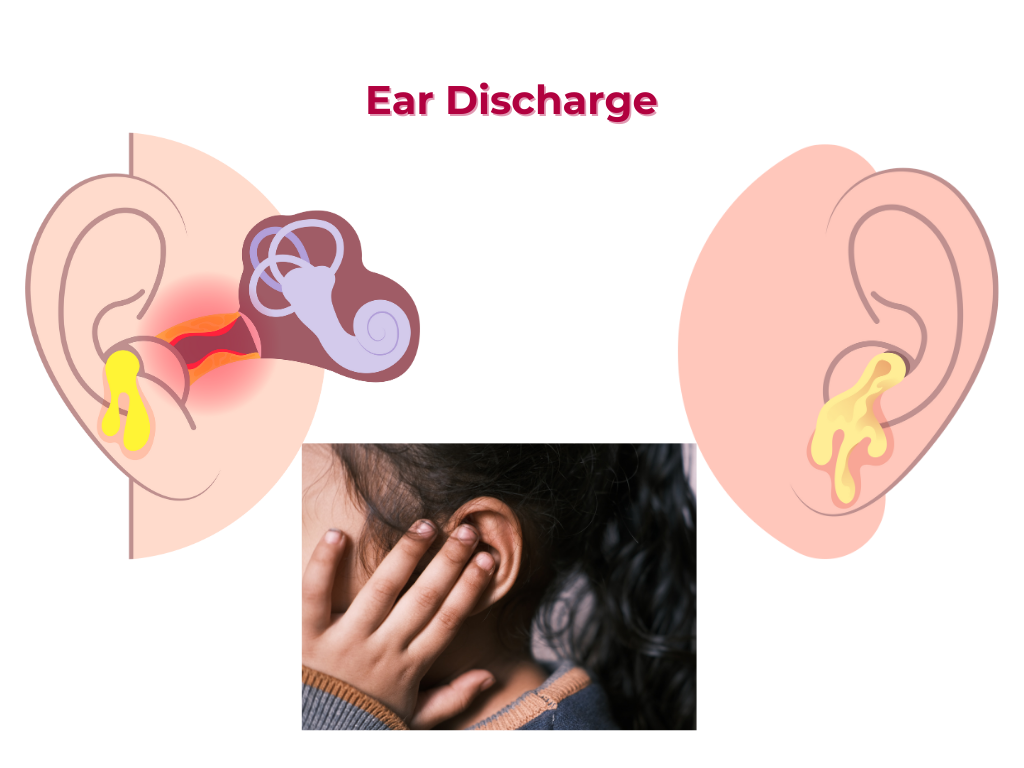The Discharging Ear In Children And Approach To Its Managements

Ear discharge, also known as otorrhoea, can be caused by various factors.
Here are some possible reasons for ear discharge in children:
Infectious Causes
-
1. Middle Ear Infection (Otitis Media)
Bacterial or viral infections can cause pus to accumulate in the middle ear, leading to discharge.
-
2. Ear Canal Infection (Otitis Externa)
Bacterial or fungal infections can cause inflammation and discharge in the ear canal.
-
3. Eustachian Tube Dysfunction
The Eustachian tube connects the middle ear to the back of the of the nose (nasopharynx). If it's blocked or not functioning properly, it can lead to infection and discharge.
Non-Infectious Causes
-
1. Earwax Buildup
Excessive earwax can cause discharge, especially if it's pushed deeper into the ear canal.
-
2. Foreign Object
If a foreign object, like a toy or a bead, is inserted into the ear canal, it can cause infection and discharge.
-
3. Allergies
Seasonal or environmental allergies can cause , rhinitis, rhinosinusitis, ear irritation and discharge.
-
4. Eczema or Psoriasis
Skin conditions like eczema or psoriasis can cause ear discharge.
Other Possible Causes
1. Tympanic Membrane Perforation: A perforated eardrum can cause discharge.
2. Cholesteatoma: A rare condition where skin cells grow in the middle ear, causing discharge and other complications.
3. Cerumen Impaction: A blockage of the ear canal due to earwax, which can cause discharge.
4. Nasopharyngeal tumours: Enquire about epistaxis, neck swelling, headache, snoring, mouth breathing etc.
When to Seek Medical Attention
If your child experiences any of the following, seek medical attention:
- Severe ear pain
- Fever over 102°F (39°C)
- Discharge that's thick, yellow, or green
- Discharge that's accompanied by a foul odor
- Hearing loss or difficulty hearing
- Dizziness or balance problems.
Here's a step-by-step guide:
Assessment and Diagnosis
-
1. 1. History taking
Ask about the duration, color, and consistency of the discharge, as well as any associated symptoms like ear pain, fever, or hearing loss, nasal discharge or rhinorrhoea etc.
-
2. Physical examination
Inspect the ear canal and eardrum using an otoscope. Examine nasal cavities for rhinitis or sinusitis
-
3. Diagnostic tests
Depending on the suspected cause, additional tests like, ear swab for culture and sensitivity, tympanometry, audiometry, or imaging studies (e.g., CT or MRI scans) may be necessary. CT/MRI of nasopharynx and neck can detect nasopharyngeal tumour with possible metastasis to neck nodes.
Management
General Measures
-
1. Keep the ear clean and dry
Gently clean the outer ear with a washcloth, avoiding the ear canal. Avoid Q-tip as much as possible.
-
2. Avoid sticking objects in the ear
Prevent further irritation or damage.
-
3. Pain management
Use acetaminophen or ibuprofen to manage ear pain.
Specific Treatments
-
1. Antibiotics
Prescribe antibiotics if the discharge is caused by a bacterial infection.
-
2. Antifungal medications
Use antifungal ear drops or oral medications if the discharge is caused by a fungal infection.
-
3. Ear drops
Use ear drops containing antibiotics, antifungals, or anesthetics as needed.
-
4. Tympanocentesis
Perform a tympanocentesis (draining fluid from the middle ear) if the discharge is caused by a middle ear infection.
Referral to Specialist
-
1. ENT specialist:
Refer the child to an ENT specialist if:
- The discharge persists or worsens despite treatment.
- There are signs of complications, such as hearing loss or facial paralysis or delayed speech.
- The child has a history of recurrent ear infections or ear surgery.
-
2. Audiology referral
Refer the child to an audiologist if there are concerns about hearing loss or delayed speech development.
Prevention
-
1. Vaccinations
Ensure the child is up-to-date on vaccinations, including the pneumococcal conjugate vaccine (PCV) and the influenza vaccine.
-
2. Ear hygiene
Teach the child and parents proper ear hygiene practices.
-
3. Avoid exposure to irritants
Reduce exposure to secondhand smoke, pollution, and other environmental irritants.
When to Seek Immediate Medical Attention
-
1. Severe ear pain
If the child experiences severe ear pain, especially if accompanied by fever or vomiting.
-
2. Discharge with blood or pus
If the discharge is bloody or purulent.
-
3. Fever over 104°F (40°C)
If the child has a high fever.
-
4. Difficulty hearing or speaking
If the child experiences hearing loss, speech difficulties, or balance problems.
By following this approach, you can effectively manage ear discharge in children and prevent potential complications such as Chronic suppurative otitis media, intracranial complications etc
Share Post On:
Recent Posts
-
Technique of Incision and Drainage of Septal Hematoma/Septal Abscess
-
Upper Aerodigestive Tract Foreign Body Impaction
-
Incision and Drainage of Hematoma Auris
-
Rigid Bronchoscopy for Retrieval of Foreign Bodies in Children
-
Foreign Body Impaction in the Larynx, Trachea, and Bronchi
-
Leadership Position is a Tool, not a Trophy
-
Carcinoma of the Oropharynx
-
Peritonsillar Abscess
-
Ethics of Doctor-Patient Relationship
-
Doctor-Patient Relationship Case Scenarios
-
Asymmetrical Tonsils and Approach to Evaluation and Management
-
Nasal Polyposis
-
Rigid Oesophagoscopy and Complication
-
Anatomy of Oesophagus
-
Stridor, Snoring, Stertor And Wheezing: How They Compare
-
Temporomandibular Joint (TMJ)
-
Otoacoustic Emissions
-
Tympanometry
-
Functional Endoscopic Sinus Surgery (FESS)
-
Tracheostomy
-
Clinical Voice Test (CVT) for Hearing Loss
-
Acute Epiglottitis And Approach To Management
-
Synoptic Overview Of Nasopharyngeal Carcinoma
-
Prioritizing Support For People With Disabilities Over Unhealthy Competitions That Marginalise The Downtrodden
-
Otitic Barotrauma
Categories
Get in Touch
Read doctor-produced health and medical information written for you to make informed decisions about your health concerns.

